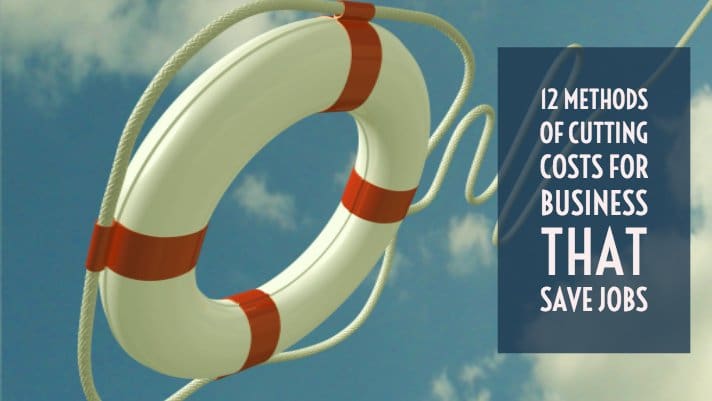
Big business is known for being ruthless when it comes to cutting costs. There’s usually barely a discussion before making the decision to lay off employees in droves to save a business that is going South. Small businesses are the exception to this rule. Employing much more than half of the U.S. Workforce, it’s the small business that works to try and find ways to keep employees by employing other cost-saving methods to save valuable jobs. So, the question becomes how to cut costs in business?
Table of Contents
ToggleCutting Costs for Business Made Simple
Now, I admit my bias here. I’m a small business owner, and I have employees who work for me. I know how difficult it is when sales are down and the bills all need to be paid. That’s the reason that I’m writing this article. If it only saves one person from one small business, it’s well worth the time invested.
To anyone who has yet to sit at the table when budget cuts are necessary, it’s difficult to fully understand the costs of laying people off. When an employee walks out that door, they’re taking more than that fancy stapler you had at their desk. Employees that leave your organization to save money are taking valuable business experience and memory as well. This is one of the hardest things to replace when it comes time to rehire. Capturing the lost business memory shows up for a minimum of 6 months to a year as new hires get acclimated to the culture and systems of the business.
Big business should take a page from the small business playbook here and look for other business cost-cutting methods to retain valuable employees who are dedicated to the organization. Hiring new employees is difficult, and retaining top talent should be core to cutting costs for any business.
12 Methods for Cutting Costs
What follows is 12 methods of cutting costs that can be used in both small and big business. Before you head for the employee ax, evaluate these methods for your business.


Method #1: Evaluate Overtime Use and Regulations
It’s quite common in a lean time for business to ax staff and expects the remainder of the workforce to pick up the pieces. What is often forgotten during this time is that overtime usually soars and staff costs can increase. If you’re going to be asking your staff to embrace a heavier workload, evaluate the workload of your current staff first. If there’s no bandwidth to pick up additional areas of responsibility, overtime will increase and productivity can easily drop. Before you make any rash staff decisions, consider which areas and tasks are essential and which could be left for a time. Overtime is a costly alternative that should be used sparingly to get things back on track.

Method #2: Consider Cloud-Based Services
Tasks that used to be handled almost entirely by third-party service companies are now attainable for your workforce. Gone are the days where tasks like customer scheduling, security, and account management need to be subbed out to another company. This cost is excessive, and the resources are available to accomplish these tasks in-house. If you’re working with a third party company that does all of your billing, there are cloud-based programs that can take care of it. With minimal training, entire areas of your business can be brought back in from third-party vendors and cloud-based solutions can save you thousands of dollars.

Method #3: Allow Your Staff To Work Remotely
One of the first “hard costs” that comes into view when looking at cutting costs is building and utility use. Do you know how much it costs to work in your building each day? If you add up the utilities, rent, paper, and other office costs, how much could you save if working remotely was encouraged? We live in a world where technology can bring us together for video meetings. Documents can be shared and edited in real time. The reasons to be in the same room with each other 5 days a week are greatly diminished from days gone by. What if you kept office hours 3 days a week and allowed working offsite the other two days? I encourage you to give it a try and watch your productivity increase.

Method #4: Offer Fewer Hours To Keep Jobs
When faced with terminating employees to keep costs down, consider reducing available hours rather than a layoff. Most staff members will accept a reduction in available hours to keep their job. I’ve even personally seen staff groups collectively reduce their hours to keep a valuable member of the team on the payroll. When you can be honest with your staff and allow them to help, you may find that they have solutions you haven’t thought of yet.


Method #5: Assign New Areas Of Responsibility For Existing Staff
During slow times of business, there are inevitably certain areas of the business where workers cease to have enough to do. Consider redistributing tasks among the staff to accomplish what must be done. Offer training for staff members moving into new areas to ensure their success. You’ll find that most people are willing to learn and try new things if the opportunity arises.

Method #6: Renegotiate Your Payment Acceptance Strategy
When it comes to hard costs for your business, one that is often overlooked is your payment acceptance strategy. Many businesses sign a contract with a merchant services company and never revisit their contract. If you’re still paying a percentage to a merchant services company to accept credit and debit cards at your business, you’re working with the wrong provider. Things have come a long way in the past few years, and you’re losing way too much money to fees. How much more money would there be back in the budget if you could accept credit cards for free? It’s possible. You just have to find the right provider. Partnering with the right merchant provider can mean thousands of dollars in savings each month. Having the right payment processing solutions for your business type is vital in any cost savings strategy.

Method #7: Evaluate Annual Raises
I don’t know a single employee that enjoys delaying raises. For most employees though, when faced with layoffs or termination, a delay in a raise is expected to increase job security. Don’t just charge blindly ahead with the ways that things have been handled in the past. Look at what has been done and evaluate if it is still appropriate for the business. Depending on the financial climate, raises and other benefit increases may need to be delayed, and that’s okay.

Method #8: Look Over The Bonus Structure
For any of us who lived through the housing crisis and ensuing recession of 2007, we know bonuses can get people into a lot of trouble. Seeing the executives of the major lenders take a bailout from the Government and then give themselves Million dollar bonuses is a jerk move. Don’t let this be you and your company. When faced with a downtime in your company, bonuses may need to be delayed or tapered to save the company. Take the temperature of the company before any bonuses are awarded. Employee morale and general good will can be adversely affected if things are handled poorly.

Method #9: Increase Staff Rewards and Incentives
Morale plays a big part in how a business rides through a down time in the business. The simple act of buying lunch for the office can go a long way to keeping morale high. If you’re asking workers to reduce their hours or take a pay decrease, what benefits could you add to go along with it? Could you increase available out of office time? What if you created a new bonus structure that wasn’t based on financial incentives, but rather tangible incentives? I’ve watched entire offices fight over something as simple as a new piece of technology that was just released. For the low price of $600, the productivity of the staff went through the roof to compete for the prize. What could be that carrot you dangle in front of your staff to increase the incentive for your workforce?

Method #10: Renegotiate Health Care Benefits
If your business offers health insurance, think about renegotiating your plan to save on cost. Increase to higher deductibles and raise the co-pay amount if necessary. If required, reduce the company portion paid per employee. Most of the people working for your company would rather pay a few hundred more dollars in health insurance and keep their jobs.

Method #11: Embrace Lean Methodologies
The employees of your company have ideas where waste is running rampant. There’s nobody better to ask where money is going to waste than the people on the front lines of your organization. People will bend over backward to support your company and your leadership if they know that you are doing all that you can to save jobs. Listen to the people under your leadership. Ask for their ideas. Cut out the waste and the convenience purchases that are running rampant in every company. Show your team that you’re all in to do everything you can to save their jobs.

Method #12: Growth Hack Your Marketing
If you’re working with an ad agency, are they paying off? If you’re in a downtime in your business, one of the first places you need to look is marketing. Remember that a great marketing agency will return much more in revenue than they are paid. If your marketing team is only bringing in enough to pay their fee, find another team or do it yourself. There are so many freelancers who can help you with various parts of your marketing. From SEO to Pay Per Click, software services abound with no shortage of freelancers who can help your growth hack your way to the top. If you’re looking for a place to start, maybe for a strategy and consulting session with a marketing agency to evaluate what’s working and what needs the ax.
Cutting Costs: There is a Solution
If you’re experiencing a downtime in your business, know that you’re in good company. There are Fortune 500 companies that are in the same boat you are right now, and you both have the opportunity to turn it around. Before you think about laying waste to employees, walk through the strategies above and do all you can to prove to your employees that you’re serious about keeping them around by cutting costs in different areas of the business. If you’re willing to put in the hard work to reduce waste and employ new methods of cost savings, you will be rewarded.










